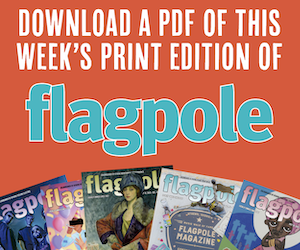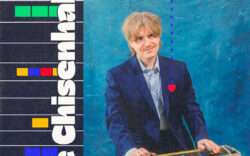Given Athens’ tendency to celebrate its past, it has been a head scratcher why the story of Limbo District has barely escaped the lips of our townsfolk for the past 40 years. Were it not for the work of Henry Owings of the Chunklet Music Preservation Project, chances are more than good that the history and mystery of one of Athens’ most forgotten bands would remain unspoken.
It all started in 1980. The late Jeremy Ayers, who performed vocals and percussion with Limbo District, had been back in Athens for a good while after his days in New York City and participation in Warhol’s factory scene. He met bassist Davey Stevenson pretty much right as he arrived in Athens from his native Dublin, GA. Then, while studying comparative literature, Stevenson met vocalist and Farfisa player Craig Woodall. This is the trio that would hold auditions requesting participants play a Chuck Berry song or “Louie, Louie,” and that’s how Dominique Amet—also on vocals and Farfisa—secured her role. She was a prefect’s daughter from Doubs, France and wasn’t familiar with either. At some point they heard a Spanish woman speaking dismissively about Athens and its people on the radio and thought, “We’ve got to get her in the band!” And that’s how guitarist Margarita Bilbão came onboard. These five formed the band’s original lineup.

Stevenson’s older brother, Gordon, was well established in New York’s no wave scene as a member of Lydia Lunch’s Teenage Jesus & The Jerks, and it’s through this connection Limbo District received its fateful introduction to photographer Marlys Lenz Cox. Fateful because were it not for her photoshoot featuring the band dressed as 19th century carnival performers—a shoot that was filmed by Jim Herbert and clips of which are seen briefly in Athens, GA: Inside/Out—nary a sound nor image would have populated the minds of curious music fans these past four decades. The band played Cox’s MFA exit show in the spring of 1981 and carried on with this lineup until the fall of that year, when Bilbão decided she’d had enough of being in a band. She was quickly replaced by Tim Lacy, who was already busy with his own band, Art In The Dark. This version of the band knuckled down, did a recording session at Smyrna’s Bombay Studio in the spring of 1982, played with stunning regularity in Atlanta and Athens, and toured up and down the coast.
On the cusp of recording at Mitch Easter’s then-newly christened Drive-In Studio in August of 1982 in Winston-Salem, NC, Lacy quit and guitarist Kelly Crow took his place. It was this session at Drive-In that the band would record the five songs contained in both Herbert’s film Carnival and on the freshly released album of the same name. At this point, the band does a few more tours, becoming something of a tiny “toast of the town” among the then-burgeoning downtown Manhattan art rock scene. By May of 1983 it would all be over with the breakup of the group initially spurred by the fizzling of Ayers and Stevenson’s romantic relationship.
Working with precious little recorded material, including live recordings, Owings has been able to wring out multiple releases, each with gorgeous packaging and thoughtful arrangements. The crowning jewel of the whole collection is Carnival. Its music is now brought into a relief that is remarkably shiny and new, courtesy of David Barbe and Jason NeSmith.
Considering the previous rarity of its recordings and continued inscrutability of its lyrical and aesthetic presentation, Limbo District is a lesson in intrigue for even jaded music fans. It’s not as if their music—heavily rhythmic, showered in Farfisa keyboard blasts, and replete with barking vocals most of the time—is entirely without precedent. The singles “Encased” and “Rhythm Forward,” each of which Owings released last year, bear the stripes of post punk and no wave. But there’s no pretending that Limbo District came out of a rock music tradition. If anything, as Owings has identified, theirs was more of an American Primitive tradition. Also of note, Owings says that absolutely none of this music is accidental, and the group was highly rehearsed. That’s to be taken literally as distinct from “practiced.” And, to this writer, rehearsing as opposed to practicing implies a theatrical tradition.
The liner notes for Carnival were compiled by writer and Flagpole contributor Chad Radford, who certainly had his work cut out for him. Ayers, Amet and Stevenson have all passed away. Lacy had zero interest in participating, and Bilbão lives in Libya. Still, with effort and determination Radford crafted a compelling narrative through the interviews he was able to secure among the band’s peers including Mitch Easter, Sam McNair (Art In The Dark), Bill Cody (Athens, GA: Inside/Out), Marlys Lenz Cox, Vanessa Briscoe Hay (Pylon), Clare Parker Butler (The Now Explosion), writer Glen Thrasher, Tom Zarrilli (manager of Atlanta club TV Dinner), and, finally, members Crow and Bilbão. Their story is told across a beautifully designed album insert that also features rare photos, which is an odd distinction to make considering how rare all this was until, basically, two years ago.
Owings also did a lot of work polishing up Herbert’s film, and has enjoyed successful screenings of the always generally available but not necessarily good-looking work. Fairly choppy copies have been available for years online, but Herbert has been pleased with Owings work on its restoration.
With any project of this sort the fact is that no one cares until someone dares. Upon being presented with this opportunity, Owings took the dare. Now, with Carnival, and the whole of this new Limbo District catalog, there is no gatekeeping. The elevator is open at the ground floor for anyone who wants to take the ride.

A Q&A with Chad Radford
Normally, the people who create and assemble an album’s constituent parts (artwork, mechanical pieces, liner notes, etc.) don’t get a whole lot of attention for the work put in. Writer Chad Radford, decades long music critic and editor, deserves some attention, though, for the extensive work he performed putting together the interviews that formed the basis for the story told in the liner notes of Limbo District’s Carnival. This short interview with Radford, originally conceived as being of use for background information only, was so fruitful it deserved to be published on its own.
Flagpole: How pointed were your interviews with these folks? That is, did you approach them “interview style” or “conversation style” where the information simply flowed and you gathered what told the story in the best way?
Chad Radford: My style tends to be pretty conversational. With folks like Mitch Easter, Marlys Cox, Glen Thrasher and Clair Butler, I just got them talking about basic things, like their friendship with Jeremy Ayers, for example. Stories grew from there. Everyone had real and deep friendships based around their shared love of music and art. Their friendships endured everything that most friendships go through (and more). I found that any lingering negativity surrounding Limbo District that I had heard chatter about didn’t exist. Everyone had such a profound sense of love and respect for the music and for the members of the group! It was disarming. [The] airing of grievances on anyone’s part just wasn’t a thing.
Maybe that’s because people are just remembering the good times, or that when people reach a certain age they let go of artistic competition and bad feelings. It speaks highly of the people who were a part of that music scene.
All I had to do was prompt people with a few well-placed questions on a broad level. Once they started talking, I tightened the focus and got into the rich details. And there were a lot! The font on those liner notes is on the threshold of being too small (for me) to read without a magnifying glass. I had to trim out a lot and keep the focus on Carnival as best I could. At one point I had a draft of those liner notes that were three times the word count that Henry [Owings] expected from me.
When he asked me how it was going, I always said, “Limbo District is the gift that keeps on giving.” Because it truly is. I spent maybe a month just lining up conversations. Every time I spoke with someone, I had a new thread to pursue. I looked for the points of overlap and weaved it all together, massaging out anything that got in the way of the flow.
I would talk with Kelly Crow, for example, who told a story that didn’t seem like it would have much bearing on the Carnival notes. Then, Sam McNair would tell the story from a slightly different angle that resonated with something that Vanessa Briscoe-Hay or Mitch Easter said. All of the sudden new elements started coming together like puzzle pieces.

FP: Can you talk a little bit about the relative (or not) difficulty in tracking all these folks down? It’s been my understanding that the surviving members, except for Kelly Crow, either have horrible memories, are unavailable or totally disinterested.
CR: Almost everyone I approached got back with me quickly. Even David Barbe, who was balancing what sounded like an insane amount of traveling with a bunch of studio projects made time to answer some questions and contribute to the story. I wish I had Todd Ploharski from Low Yo Yo Stuff Records’ voice in there. He was the first person who told me about Limbo District. It would have been great to get Tim Lacy from Art In the Dark (one of my favorite Athens bands ever) in there. He played guitar for the Carnival recording. After that, he was out! I can’t say that I encountered any disinterest from anyone I approached. If they didn’t want to talk, or were too busy, or whatever, they just didn’t respond. I already had a lot to wrangle, though.
What’s funny is, I had sent a message to Margarita Bilbão, an original member of the group, who now lives in Libya. I spent a couple of days putting together questions for her and emailed them. Radio silence ensued. I stayed up late one night, finished the liner notes and turned them in. Job’s done, right! Let’s all get a beer! Literally two hours after singing off I got a reply from Margarita! She had great things to say, and it would have been a crime not to include her. So I had a “stop the press” moment. I was able to work in the best parts of her answers at the expense of some font size.
As far as bad memories go, I encountered some conflicting memories here and there. Some people told me the same stories from their perspectives and facts, locales, etc. didn’t match up. So I did some A-B comparisons and reached out to everyone to check facts. They quickly agreed or at least conceded on the details.
I particularly loved that [musician, writer, and publisher] Glen Thrasher from LowLife Magazine/Destroy All Music wanted to talk about Limbo District. [In his writing] he did an awful lot to comment on and document good and interesting, if not always easy-to-process, music from Athens and Atlanta. I feel that his efforts are largely unsung. He was the only writer from around these parts that I know of who recognized how great Limbo District was. With the Live Limbo LP, Henry included a story that Glen wrote for the Georgia State Signal back in the early ‘80s. He saw the greatness in the group way back then! He has a reputation for being a tough nut to crack, but there was absolute excitement and reverence in his voice when he started telling stories about driving Limbo District to play their first New York, Boston and Philadelphia shows.

FP: How exactly did you come to be involved in Henry’s shenanigans? I kid, but seriously, how did you become involved in this project? The credit is enviable but the task is not.
CR: Henry and I have been acquaintances through the music scene since the late ‘90s. When I moved here and started writing about music, his shows happened to be what I was looking for: Don Caballero and Black Heart Procession at Eyedrum. The Melvins with David Yow at Whirlyball. Man? Or Astro-Man at Whirlyball. I Am Spoonbender at Echo Lounge. That list went on and on for decades. We were always friendly with each other, but never too close. If ever I had a question, or wanted a guest list spot, or needed anything for a story, Henry was always accommodating. As a writer, and later as the music editor for Creative Loafing, there was always a lot of pressure from the top down to not have, or at least to downplay, friendships that I had within the local music scene. It kept me honest and avoided conflicts of interest. It’s part of the job. I still have that distanced relationship with some musicians and promoters in Atlanta. It’s difficult, though, because writing about music is not like writing about any other discipline. Writing about music is a vocational thing, and you have to be close to it to do it justice. I could go on for pages and pages about my feelings on this, but I’ll spare you.
When Henry was working on his books of flyers, Plus 1 Athens and Plus 1 Atlanta, I was working on my book, Atlanta Record Stores. That spawned a few conversations between us, mostly about what a shame it is that, in the big picture, Atlanta’s music history has been so poorly documented for decades. There are books about New York, Chicago, Los Angeles, Detroit, you name it! Atlanta, not so much, and it really got a shamefully half-assed diss in Steven Blush’s American Hardcore.
There is a metric ton of history here that is completely buried. We both started thinking about new projects that need to be completed.
During the pandemic, I had written a large feature story about Neon Christ for a European hardcore magazine called Down For Life. That also got us talking about an even older Atlanta hardcore band called DDT. At the time, their Brave New World 7-inch was fetching like $700 on Discogs.
One day, Henry approached me and asked if I was interested in writing some liner notes for a reissue of the DDT 7-inch. I thought, hell yes! Not only will I finally be able to have a vinyl copy of these songs that I can drop a needle on, and it will have notes written by me! So I interviewed Jim Younge from the group and made that happen. Henry knew that I had poked around in the past, looking for info about Limbo District. Henry started cranking out the singles, and did a listening party at Ella Guru Records. It was rad to hear a test pressing of the Carnival stuff. I caught wind of the Guardian story that was in the works!
I thought, damn. Only Henry is persistent and tenacious enough to make this happen. I was stoked for it! Then he asked if I was interested in doing liner notes for Carnival. My brutal vinyl addiction kicked in and I thought, “Could I really have a vinyl copy of Carnival to play and to covet, with liner notes? I didn’t hesitate for a second saying yes. An oral history was the way to go, and it put me in a position to have some cool conversations with Mitch Easter, Vanessa from Pylon, and with Marlys Cox. Marlys’ role is often overshadowed in the story, so it was cool to hear about the concept behind the Carnival photo shoot. I talked with everyone about all sorts of things that these folks don’t typically talk about in interviews, and that was exciting for everyone.
Like what you just read? Support Flagpole by making a donation today. Every dollar you give helps fund our ongoing mission to provide Athens with quality, independent journalism.










